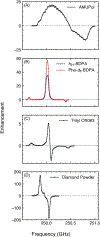Frequency-swept dynamic nuclear polarization
- PMID: 37385067
- PMCID: PMC11549732
- DOI: 10.1016/j.jmr.2023.107511
Frequency-swept dynamic nuclear polarization
Abstract
Dynamic nuclear polarization (DNP) improves the sensitivity of NMR spectroscopy by the transfer of electron polarization to nuclei via irradiation of electron-nuclear transitions with microwaves at the appropriate frequency. For fields > 5 T and using g ∼ 2 electrons as polarizing agents, this requires the availability of microwave sources operating at >140 GHz. Therefore, microwave sources for DNP have generally been continuous-wave (CW) gyrotrons, and more recently solid state, oscillators operating at a fixed frequency and power. This constraint has limited the DNP mechanisms which can be exploited, and stymied the development of new time domain mechanisms. We report here the incorporation of a microwave source enabling facile modulation of frequency, amplitude, and phase at 9 T (250 GHz microwave frequency), and we have used the source for magic-angle spinning (MAS) NMR experiments. The experiments include investigations of CW DNP mechanisms, the advantage of frequency-chirped irradiation, and a demonstration of an Overhauser enhancement of ∼25 with a recently reported water-soluble BDPA radical, highlighting the potential for affordable and compact microwave sources to achieve significant enhancement in aqueous samples, including biological macromolecules. With the development of suitable microwave amplifiers, it should permit exploration of multiple new avenues involving time domain experiments.
Copyright © 2023 Elsevier Inc. All rights reserved.
Conflict of interest statement
Declaration of Competing Interest The authors declare that they have no known competing financial interests or personal relationships that could have appeared to influence the work reported in this paper.
Figures






References
-
- Abragam A, The Principles of Nuclear Magnetism, Clarendon, Oxford, England, 1961.
-
- Overhauser AW, Polarization of nuclei in metals, Phys. Rev 92 (1953) 411.
-
- Slichter CP, Principles of Magnetic Resonance, 3rd ed., Springer-Verlag, 1989.
-
- Lilly Thankamony AS, Wittmann JJ, Kaushik M, Corzilius B, Dynamic nuclear polarization for sensitivity enhancement in modern solid-state NMR, Progr, Nucl. Magn. Reson. Spectrosc 102–103 (2017) 120–195. - PubMed
-
- Becerra LR, Gerfen GJ, Temkin RJ, Singel DJ, Griffin RG, Dynamic nuclear polarization with a cyclotron resonance maser at 5 T, Phys. Rev. Lett 71 (1993) 3561–3564. - PubMed
Grants and funding
LinkOut - more resources
Full Text Sources

